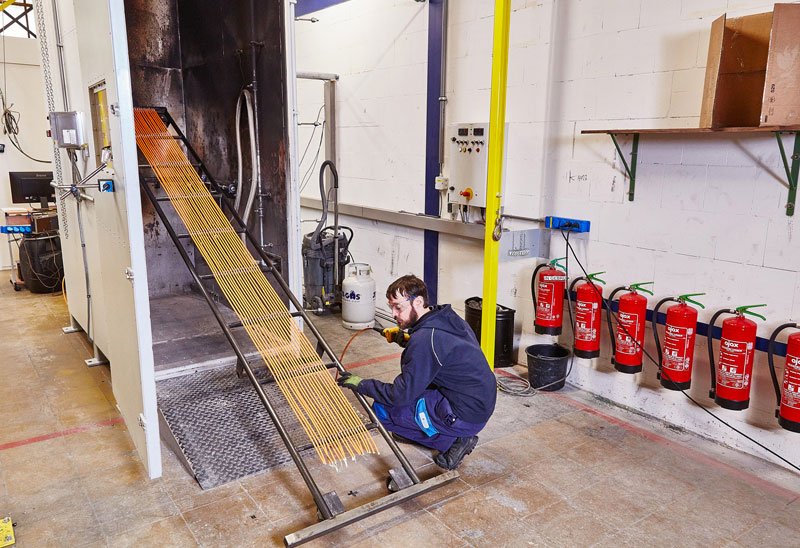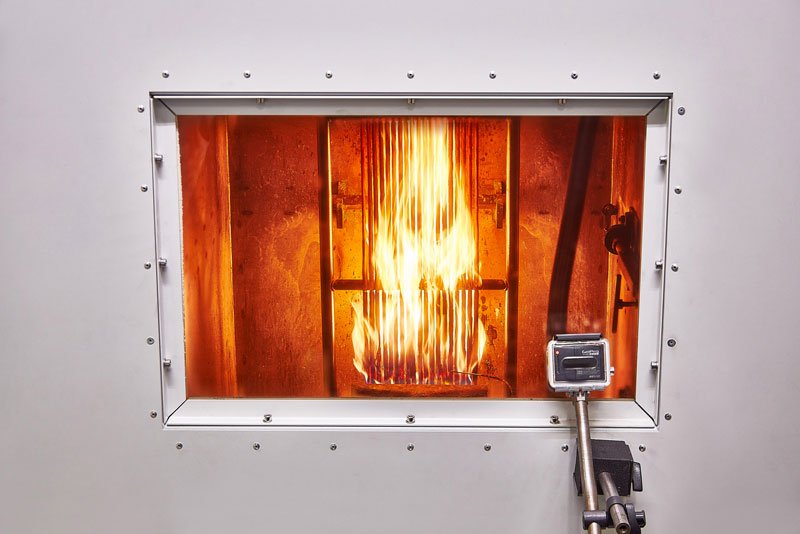CPR: Construction Product Regulation
Driving Enhanced Safety for People in Case of Fire
Defining and implementing a harmonized reaction to fire classification for permanently installed products in European countries, the European Construction Product Regulation (CPR) enables an improved controlled safety in case of fire.
-
Overview
-
Understanding CPR
-
Euroclass Selection
-
AVCP & DoP
-
CPR Testing by Belden
-
FAQ
In the case of fire, the safety of people within constructions is heavily influenced by the contribution of permanently installed products to the fire spread, which especially impacts Belden's large wire and cable portfolio.
While in the United States and Canada, this safety aspect is covered by the NFPA and CSA standards, in Europe, a step towards harmonization of local legislation has been taken through the Construction Product Regulation (CPR) and associated European classification system (generally referred to as Euroclass), which sets harmonized rules and flame performance levels for products meant to be permanently installed in constructions.
Through early investment into an on-site fire testing facility, Belden has developed an in-depth knowledge of the behavior of wire and cable designs in the case of fire. This experience enables us to offer an extended product capability and assurance to meet the level of fire performance adapted to your application.
Please check the available designs on our available CPR rated cable product listing CPR copper Cable or CPR Fiber Cables. If your desired product is not readily available, please reach out to our Belden representative for a project quotation.
CPR refers to Regulation (EU) No 305/2011, which describes the harmonized conditions for the marketing of construction products. It repealed the Construction Products Directive 89/106/EEC.
CPR sets out the conditions for the marketing of construction products, as well as methods and criteria for assessing and expressing the performance of construction products and the conditions for the use of the CE marking in Europe in a similar way as the UKCA marking in the United Kingdom.
The regulation sets rules for mechanical resistance and stability, safety in case of fire, hygiene, health and the environment, safety and accessibility in use, protection against noise, energy economy and heat retention, and sustainable use of natural resources.
However, the member states remain responsible for fire safety, mechanical resistance, and stability, environmental, energy, and other requirements applicable to buildings and other construction works. From a functional point of view, cable products are mainly impacted by the aspect of safety in case of fire.
Main harmonized standard for power, control, and communication cables:
EN50575 covers the requirements for power, control, and communication cables used for general applications in construction works subject to reaction to fire requirements (not covering circuit integrity application). It refers to EN 13501-6 regarding the reaction to fire. The various ratings and implications for safety in the case of fire are described at a high level in Annex A of this document. EN 50575 also requires an Assessment and Verification of Consistency of Performance (AVCP) which must be declared using a Declaration of Performance (DoP). Here, B2ca and Cca classified cables fall into the System 1+ category, which requires an audit of the factory and yearly re-testing of the cable. Dca and Eca are in System 3, which only requires an initial type-testing..
Levels of safety in case of fire – Euroclass classification
CPR classifies several factors for assessing the contribution of a product to a fire. A rating is composed of four factors: Fire Spread Class, Smoke Production (s), Flaming Droplets (d), and Acidity (a). These factors are described at a high level in the table below.
List of impacted countries:
According to the CEN/CENELEC Internal Regulations, the national standards organizations of the following countries are bound to implement the EN 13501-6 European Standard: Austria, Belgium, Bulgaria, Cyprus, Czech Republic, Denmark, Estonia, Finland, France, Germany, Greece, Hungary, Iceland, Ireland, Italy, Latvia, Lithuania, Luxembourg, Malta, Netherlands, Norway, Poland, Portugal, Romania, Slovakia, Slovenia, Spain, Sweden, Switzerland, and United Kingdom.
The required CPR-Euroclass level is depending on the regulation at country level. Each country (or national organizations) defined or is currently defining either compulsory or recommended CPR-Euroclass level which generally depends on the application and types of construction. As an example, the below table provides a simplified overview of the required or recommended CPR classifications level for some of the largest European countries.
Belden therefore recommends referring to the up-to-date regulation to define your needs in term of CPR level. Yet, in the wish to standardize our offering to cover most countries, we will aim towards the following Euroclass levels:
- High performance: B2ca s1a,d1,a1
- Medium to high performance: Cca s1b,d1,a1
- Medium to Low performance: Dca s1,d2,a1
- Minimum performance: Eca
Additionally, upon requests, the smoke type test s1a or s1b can easily be added. We can also offer custom made designs meeting the required CPR level.
EXAMPLE OF THE ENFORCEMENT LEVEL PER COUNTRY AND APPLICATION:
Case of circuit integrity Cables:
Although the EN50575 standard does not cover cables which are essential to ensure the continuity of power or signal of safety installations, these may still be interpreted as included if they also have the objective of limiting the generation and spread of fire and smoke. Additionally, as shown in Annex C, some countries advise high CPR levels for emergency routes. Therefore, in addition to the required fire-resistant standards, Belden recommends the use of CPR classification for circuit integrity cables in Europe. This way, you maximize your chance to be meet the local norms while enhancing the safety of people in case of fire. This recommendation is expected to be included in the harmonized standard in the next years.
AVCP stands for “Assessment & Verification of Constancy of Performance” and requires the compliance of power, control, and communication cables with CPR requirements. The performance (including classes) declared by the manufacturer in the Declaration of Performance (DoP) shall be demonstrated by:
- Determination of product-type
- Factory production control (FPC) by the manufacturer, including product assessment
The manufacturer shall always retain overall control and shall have the necessary means to take responsibility for the conformity of the product with declared performance.
The level of assessment and verification of constancy of performance varies depending on the Euroclass. The following table describes the corresponding systems of AVCP and as summary of their impact in term of verification.
Declaration of Performance
The Declaration of Performance (DoP) expresses the Euroclass performance of cables. It defines the product, its intended use, and its essential characteristics. A Declaration of Performance requires the manufacturer, importer or distributor to assume legal responsibility for the conformity of the construction product with its declared performance.
You can generate DoP certifications via the Belden Online Euroclass Checker & DoP Generator.

With investments in state-of-the-art equipment and dedicated resources, Belden has established an internal testing facility where we measure cabling product reaction to fire tests as per EN 50399 and EN 60332-1 standards. The smoke production testing as per EN 61034-2 and acidity as per EN 50267-2 are tested externally.
Following a demanding test schedule, Belden cables are tested and certified to meet CPR standards including Heat release, Flame spread, Smoke production, and Flaming droplets. When a cable is assessed, the CPR rating and CE mark are added to the print on the cable and on the label.




Verifying Consistency of Performance—Plant Audits
For manufacturing plants producing products in the AVCP 1+ system (Euroclass B1, B2 & C), a bi-annual plant audit is required. These audits focus mainly on the measures the manufacturer has in place to guarantee the constancy of the product's quality. Belden’s plants routinely pass these audits without issue, after testing from a CPR Notified Certification Body.
A CPR Notified Certification Body also completed the 'System Audit' on Belden processes. This audit focuses on the administrative processes of the testing procedure. During the audit, quality control procedures as well as testing system processes are checked and audited. The testing system process includes auditor review of how samples are collected, stored and conditioned. For example, samples should be clearly identifiable and stored in an orderly (not random) manner. Sample traceability is also audited to verify a manufacturer can verify reel source (e.g, who produced it & if any defect(s) were registered during manufacturing).
Belden has also undergone a technical audit focused on our testing apparatus. Testing equipment is thoroughly checked for compliance with the appropriate standardfrom the geometry of the test chamber to the calibration data and certification of individual components. This is a full-day audit carried out by a CPR Notified Lab.
What is the status regarding the Brexit?
Please check the following UK government website for the latest up to date UKCA CPR update. On Dec 9, 2022, the use of the CE mark was extended until 30 June 2025. After this date, the UKCA mark will be required to supply good to the market in Great Britain. For Northern Ireland, the following guidance page is to be checked governmental guidance page.
What is a manufacturer's responsibility relative to CPR?
There are certain rules that manufacturers must follow prior to placing a product on the marke. Manufacturers must make a Declaration of Conformity/Performance stating the Euroclass or UKCA performance when applicable for the specific product. This is followed by affixing the CE and/or UKCA marking and retaining all related documentation for a period of 10 years.
Depending on a product's Euroclass and/or UKCA, manufacturers may also be required to monitor the product (including sample testing as per additional AVCP requirements). Furthermore, manufacturers must ensure the product classification is easily identifiable, provide contact information and safety instructions/information in appropriate languages. Manufacturers must also take corrective measures when necessary and cooperate with requests from authorities.
What are the responsibilities of end-users relative to CPR?
When working with the project team to draw up specifications, end-users should refer to the harmonized technical specifications (specifically to the requirements of individual characteristics).
When choosing products for construction projects, end-users should review the Declaration of Conformity/Performance from the manufacturer. They must also check national annexes or standard recommendations, which offer guidance about appropriate minimum product performance levels. Compliance with local building regulations should also be followed by end-users.
What are the responsibilities of integrators relative to CPR?
Integrators have several responsibilities like those of end-users.
They should refer to the harmonized technical specifications (specifically to the requirements of individual characteristics) when drawing up project specifications. When selecting products for use in European buildings, integrators should be sure to review the manufacturer’s Declaration of Conformity/Performance. They must also check national annexes or standard recommendations for guidance on appropriate minimum product performance levels. Compliance with local building regulations should also be ensured.
What are Notified Bodies?
A Notified Body is an independent, third-party entity recognized by the European Union or UK when UKCA applicable. CPR includes three types of Notified Bodies being Product Certification, Factory Production Control Certification, and Product Testing Laboratory.